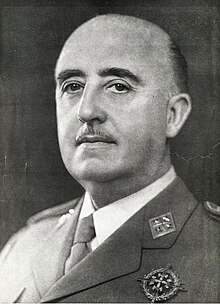Francisco Franco (Francisco Paulino Hermenegildo Teódulo Franco Bahamonde Salgado Pardo de Andrade, 4 December 1892 – 20 November 1975)[2] was a Spanish military leader who ruled as fascist dictator of Spain from 1939 until his death.
Francisco Franco | |
|---|---|
 | |
| Caudillo of Spain[b] | |
| In office 1 October 1936[a] – 20 November 1975 | |
| Preceded by |
|
| Succeeded by | Juan Carlos I (King of Spain) |
| Prime Minister of Spain[c] | |
| In office 30 January 1938[a] – 9 June 1973 | |
| Deputy | |
| Preceded by |
|
| Succeeded by | Luis Carrero Blanco |
| Personal details | |
| Born | 4 December 1892 Ferrol, Galicia, Kingdom of Spain |
| Died | 20 November 1975 (aged 82) Madrid, Spanish State |
| Cause of death | Septic shock |
| Resting place | Mingorrubio Cemetery, El Pardo, Madrid, Spain |
| Political party | FET y de las JONS |
| Spouse(s) | |
| Children | María del Carmen |
| Mother | María del Pilar Bahamonde |
| Father | Nicolás Franco |
| Relatives | Nicolás Franco (brother) Ramón Franco (brother) Francisco Franco (cousin) Ricardo de la Puente (cousin) |
| Residence | El Pardo, Madrid |
| Education | Infantry Academy of Toledo |
| Signature | |
| Military service | |
| Nickname(s) | Caudillo |
| Allegiance | (1907–1931) (1931–1936) (1936–1975) |
| Branch/service | |
| Years of service | 1907–1975 |
| Rank | Captain general of the Army Captain general of the Air Force Captain general of the Navy |
| Commands | All (Generalísimo) |
| Battles/wars | 2nd Melillan Campaign (WIA) Rif War Revolution of 1934 Spanish Civil War Ifni War |
His ideology was called Francoism (Spanish: franquismo) or Falangism
Life
changeCivil war
changeHe was a leader of a coup d'état against the Spanish Second Republic in 1936. After this uprising the Spanish Civil War started. Franco was supported by fascists, big businesses, the church, conservative people and Spanish nationalists. The Spanish Republic had a socialist government that wanted to make businesses and the church less powerful.[3] The Republic also set up local parliaments in the regions of Spain. Nationalists thought this was wrong and would make Spain weak.
Three of the leaders of the coup died. Franco led the Army of Africa, the best part of the Spanish Army. He became the only leader.
World War Two
changeFranco remained neutral during World War II as Hitler did not accept his conditions for Spain to join the Axis powers. Franco wanted Gibraltar and part of French North Africa. He allowed a group of volunteer soldiers to join the German Army to fight the Russians between 1941 and 1943. They were called the División Azul (Blue Division)[4][5]
Death
changeFranco died in Madrid on November 20, 1975, just after midnight of heart failure. Relatives, such as his daughter Carmen, had asked doctors to remove his life support systems. After Franco's death, Juan Carlos became king.[6]
References
change- ↑ 1.0 1.1 In civil war until 1 April 1939.
- ↑ The appointment decree referred to Franco as "Head of the Government of the Spanish State", a term which, by the 30 January 1938 decree, was re-coined as simply "Head of State".
- ↑ The post of Prime Minister was attached to that of Head of State until the 1967 Organic Law of the State, with the separation coming into force with Francos resignation as Prime Minister on 9 June 1973.[1]
- ↑ "Ley 14/1973, de 8 de junio, por la que se suspende la vinculación de la Presidencia del Gobierno a la Jefatura del Estado" (PDF). Boletín Oficial del Estado (in Spanish) (138). Agencia Estatal Boletín Oficial del Estado: 11686. 9 June 1973. ISSN 0212-033X.
- ↑ [1] (actually says Nov 19)
- ↑ Beevor, Antony (2001). The Spanish Civil War. London: Penguin. ISBN 0-14-100148-8.
- ↑ Kleinfeld, Gerald R; Tambs, Lewis A (1979), Hitler's Spanish Legion: The Blue Division in Russia, Southern Illinois University Press, ISBN 0-8093-0865-7
- ↑ Moreno Juliá, Xavier (2005), La División Azul: Sangre española en Rusia, 1941-1945, Barcelona: Crítica
- ↑ "Francisco Franco Bahamonde". Archived from the original on 2016-03-04. Retrieved 2013-12-29.